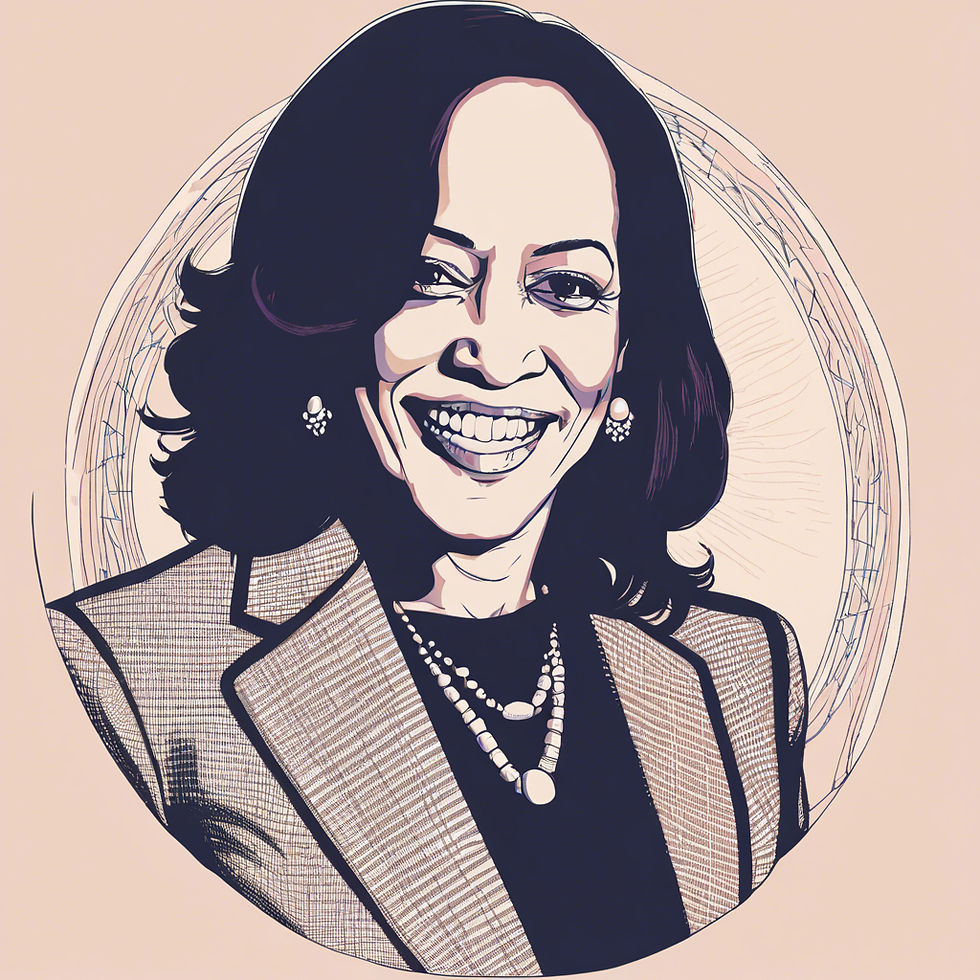A Comparative Analysis of Kamala Harris and Donald Trump’s Education Policies: Why Kamala Harris Offers the Superior Path
- Peace Love Education

- Aug 29, 2024
- 6 min read

The education policies of Kamala Harris and Donald Trump reflect fundamentally different approaches to shaping America's future. While Trump's tenure was marked by efforts to privatize education, reduce federal oversight, and slash education funding, Kamala Harris has consistently advocated for a more equitable and inclusive system. Harris’ focus on increasing federal investment in public schools, supporting teachers, and ensuring that all students have access to quality education, regardless of their background, presents a far more effective and compassionate vision for the nation's educational future. This article will delve into the stark differences between these two leaders' approaches and make a compelling case for why Kamala Harris’ education plan is the better choice for America.
Kamala Harris' Education Policies: A Vision for Equity and Excellence
Kamala Harris has long championed policies designed to ensure that every child receives a quality education, no matter their race, socioeconomic status, or geographic location. Her approach to education is grounded in several key pillars, each supported by data and research:
Substantial Federal Funding for Public Education: Harris advocates for significantly increasing federal investment in public schools, particularly in low-income areas. She has proposed directing an additional $315 billion over ten years to Title I schools, which predominantly serve students from low-income families. Research shows that increased funding in underfunded schools leads to better student outcomes. For example, a study by the National Bureau of Economic Research found that a 10% increase in per-pupil spending can result in a 7% increase in graduation rates and a 10% increase in lifetime earnings for students. This targeted funding could help reduce the disparities that have long plagued American public education, ensuring that every child has the resources needed to succeed.
Elevating Teacher Salaries: Harris’ proposal to raise teacher salaries by an average of $15,000 per year addresses one of the most pressing issues in education today: the teacher pay gap. Teachers in the United States earn approximately 20% less than other professionals with similar levels of education and experience, according to the Economic Policy Institute. This pay gap contributes to teacher shortages, as low salaries drive qualified educators out of the profession. Harris’ plan to close this gap is crucial for retaining talented teachers and attracting new ones, which is essential for maintaining the quality of education. Furthermore, research indicates that higher teacher salaries are associated with better student performance, making this investment not just beneficial for educators, but for students as well.
Universal Pre-K: One of the most transformative elements of Harris’ education platform is her commitment to universal pre-kindergarten. Studies from the National Institute for Early Education Research have shown that children who attend high-quality pre-K programs are more likely to succeed academically and socially throughout their school years. By providing universal access to pre-K, Harris is addressing educational inequities at their root. Currently, only 44% of 4-year-olds in the U.S. are enrolled in state-funded preschool programs. Harris’ plan would ensure that all children, regardless of their family’s income, have access to early childhood education, setting them on a path to success from the very beginning.
Comprehensive Student Debt Relief: Harris also recognizes the crippling impact of student debt on millions of Americans. Her proposal to forgive up to $20,000 in student loans for Pell Grant recipients and make community college free would alleviate the burden on lower-income students and their families. The Federal Reserve estimates that student loan debt in the U.S. has ballooned to over $1.7 trillion, with many young adults delaying home purchases, starting families, or even saving for retirement because of this debt. By tackling the student debt crisis head-on, Harris is not only promoting economic equity but also ensuring that higher education remains accessible to all, not just the privileged few.
Donald Trump’s Education Policies: Privatization and Disinvestment
Donald Trump’s approach to education during his presidency was characterized by a focus on privatization, deregulation, and reducing federal investment in public schools. While these policies were promoted under the guise of “school choice” and “local control,” the reality is that they often undermined public education, exacerbated inequalities, and weakened the overall quality of education in the United States.
Emphasis on School Choice and Vouchers: Trump, alongside his Education Secretary Betsy DeVos, was a staunch advocate for expanding school choice, including the use of vouchers to attend private and charter schools. However, the evidence suggests that voucher programs often fail to deliver on their promises. According to the Center on Budget and Policy Priorities, voucher programs can drain resources from public schools, which serve the vast majority of students, and do not consistently lead to better student outcomes. Moreover, these programs can deepen educational inequalities by benefiting more affluent families who can already afford private education, leaving public schools with fewer resources to educate the students who remain.
Significant Cuts to Education Funding: Trump's administration proposed deep cuts to the Department of Education’s budget, including a nearly $8.5 billion reduction in 2020. These cuts would have eliminated funding for critical programs such as after-school care, teacher training, and special education services. The potential impact of these cuts cannot be overstated: according to the Learning Policy Institute, reductions in federal education funding disproportionately affect low-income students and students with disabilities, who rely on these programs to succeed. By attempting to slash education budgets, Trump’s policies threatened to widen the achievement gap and further strain already underfunded public schools.
Rolling Back Protections and Oversight: The Trump administration also rolled back numerous protections for students, particularly those related to civil rights and campus safety. This included rescinding Obama-era guidelines that protected transgender students and scaling back Title IX protections against sexual assault in schools. These actions made it more difficult for vulnerable students to access a safe and supportive learning environment. The rollback of these protections also signaled a broader push for deregulation, which, while framed as reducing federal overreach, often left schools without the oversight needed to ensure that all students’ rights were protected.
Why Kamala Harris’ Plan is the Superior Choice for America's Educational Future
Kamala Harris’ education policies represent a comprehensive, data-driven approach to addressing the systemic issues that have long plagued American education. By focusing on equity, increased funding, and support for teachers, Harris is laying the groundwork for a more just and effective education system.
Data and Evidence: Research consistently supports the effectiveness of Harris’ proposed policies. For example, studies have shown that increased funding for public education leads to better outcomes for students, particularly in low-income areas. The National Bureau of Economic Research found that schools that receive more funding are able to offer more comprehensive educational services, leading to higher graduation rates and better long-term economic outcomes for students. Harris’ plan to direct additional funding to Title I schools is thus a crucial step toward closing the achievement gap.
Support for Teachers: Harris’ commitment to raising teacher salaries is especially timely given the current teacher shortage crisis. According to the National Education Association, the U.S. is facing a shortage of over 300,000 teachers. This shortage is exacerbated by low pay, high stress, and inadequate support. Harris’ proposal to increase teacher salaries and provide additional resources for professional development would help to attract and retain qualified educators, ensuring that students have access to the high-quality education they deserve.
Universal Pre-K: By advocating for universal pre-kindergarten, Harris is addressing educational inequities at their earliest stage. Research shows that early childhood education is one of the most effective ways to improve long-term academic outcomes and reduce achievement gaps. The National Institute for Early Education Research found that children who attend high-quality pre-K are more likely to graduate from high school, attend college, and have higher earnings as adults. Harris’ plan would ensure that every child, regardless of their background, has access to this critical foundation for success.
Addressing Student Debt: Harris’ student debt relief plan is also a critical component of her education platform. The burden of student debt has reached unprecedented levels, with the average borrower owing over $30,000. Harris’ proposal to forgive up to $20,000 in student loans for low-income borrowers and make community college free would help to alleviate this burden, making higher education more accessible and promoting economic mobility for millions of Americans.
Conclusion
The stark contrast between Kamala Harris and Donald Trump’s education policies highlights the importance of choosing leaders who prioritize equity, access, and investment in our nation’s future. Harris’ comprehensive approach to education, supported by data and evidence, offers a clear path toward a more just and effective education system. Her focus on increasing funding for public schools, supporting teachers, and expanding access to early childhood and higher education is not only the morally right choice but also the most effective strategy for ensuring that every child in America has the opportunity to succeed.
Resources:
National Bureau of Economic Research: "The Impact of Increased School Funding on Student Outcomes" (2020)
Economic Policy Institute: "The Teacher Pay Penalty" (2022)
National Education Association (NEA): "Teacher Shortages and Their Impact on Education" (2021)
Center on Budget and Policy Priorities: "The Impact of Vouchers on Public Schools" (2019)
National Institute for Early Education Research: "The Benefits of Universal Pre-K" (2021)
Federal Reserve: "Student Loan Debt Statistics" (2022)



Comments